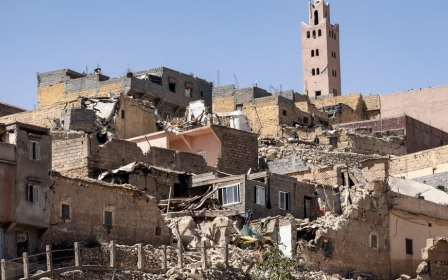Morocco earthquake: Shattered mountain villages wait for help in the epicentre

In the mountainous and remote town of Ighil, southwest of Marrakech, residents from surrounding villages gather in a corner of a partly damaged primary school.
They sit around classroom desks, against a backdrop of crumbling, rust-coloured walls, drinking coffee and passing around circular loaves of bread. Hopes of official help fading fast, the residents in this shattered place have just their neighbouring communities to thank for these small pieces of relief.
The epicentre of Morocco's 6.8-magnitude earthquake, which struck on Friday night and has so far claimed the lives of around 2,500 people, was near Ighil in al-Haouz province.
Ighil is a small town and rural commune of around 27 villages that sit high up in the Atlas mountains, where peaks can be seen rising and falling on the horizon. Once picturesque, this community, 72km southwest of Marrakech, is now a disaster zone.
Some 5,000 people lived here before the earthquake struck. At least 1,400 are thought to have been killed in the province it lies in.
New MEE newsletter: Jerusalem Dispatch
Sign up to get the latest insights and analysis on Israel-Palestine, alongside Turkey Unpacked and other MEE newsletters
Cars peek through mountains of rubble. Women salvage pieces of material from their village homes to create a makeshift sleeping area and shade themselves from the beating sun.
Despite the high death toll, and being caught in one of the areas worst affected by the quake, locals say they are yet to receive any proper international support or aid from authorities.
“It’s the locals from nearby villages who are helping us,” an elderly resident told Middle East Eye. “Young boys from other villages are walking around 16-20 kilometres to bring us this bread.”
'Young boys from other villages are walking around 16-20 kilometres to bring us this bread'
- Elderly resident of Ighil
Following the earthquake, residents of Ighil gathered together to support one another. Venturing back into what was left of their homes, they collected and pooled everything they could: bread, olive oil and other basics and necessities.
The food has been shared between the families, while young men have taken it upon themselves to walk for miles to bring back bread from communities that are less remote and didn't suffer as much destruction.
“You can only imagine how people feel walking for hours and carrying the bread to bring it to survivors, it’s hard to even describe,” one man said.
“People here only got bread three days after the earthquake, on Monday at 11am.”
Processing the earthquake
When the tremors struck, most Ighil residents were in their homes as the walls began to wobble and windows shattered.
“We were sitting around the table for our evening meal when the ground started to shake,” an elderly man recalled with tears in his eyes.
He lost his friend and uncle in the quake, and said many survivors are suffering from multiple injuries, including broken bones.
Without proper shelter, residents have been left out in the harsh sun during the day, and have no place to sleep at night. Women can be heard weeping constantly.
Many residents are still struggling to process the loss and devastation four days after the quake.
“This is God’s will and we accept it. All praise be to God,” a group of survivors say repeatedly in unison.
In the commune's villages, people are also struggling due to the power outages, blocked roads and connection failures.
Nine kilometres away in the town of Amizmiz, which is home to 20,000 people and is also in al-Haouz province, people are still searching for survivors beneath the rubble, using their bare hands and whatever basic tools they can access.
Mountain towns like Amizmiz are difficult to access in the best of times, slowing any attempt to bring in help. Even in Amizmiz, which is at the foot of the mountain range, it took five hours for the first outside aid to arrive.
Surrounding villages known as douars, communities of indigeneous Amazigh people, have seen their traditional mudbrick buildings fall apart, with entire families wiped out.
Road blockages
By 12pm on Monday, a small group of Moroccan soldiers managed to navigate the ruined mountain roads and reach Ighil. They began clearing the roads of debris to allow ambulances and other aid to arrive.
Elsewhere, residents scaled hilltops and waved as helicopters and planes carrying aid circled above them.
'Some of the villages here were directly above the earthquake and they have been completely flattened. Not a single house is left standing'
- Earthquake survivor
Debris and crumbling buildings have continued to cause deaths, with residents of Ighil saying that six people were killed by falling masonry following the quake.
“Some of the villages here were directly above the earthquake and they have been completely flattened. Not a single house is left standing,” another resident told MEE.
Some of the smaller villages only have 12-15 survivors left in them, he added.
Ighil started burying its dead on Sunday, when they gathered to pray in congregation.
Following the earthquake, Morocco declared three days of mourning and King Mohammed VI called for prayers for the dead to be held at mosques across the country.
Middle East Eye delivers independent and unrivalled coverage and analysis of the Middle East, North Africa and beyond. To learn more about republishing this content and the associated fees, please fill out this form. More about MEE can be found here.





